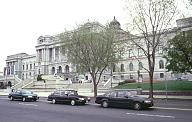
|
The entrance facade--470 feet longAlthough the Congress in 1800 established the Library of Congress as a legislative library, it has become essentially the national library of the United States and the largest library in the world. See this official site for the history of the Library of Congress. The building is made of close-grained granite, quarried in New Hampshire. The lowest register is rusticated and the quoins are vermiculated granite blocks (with "worm tracks" carved in them). |
| |
|
| This logically organized Beaux-Arts building has an entrance pavilion with an impressive double staircase meeting at the arcaded entrance on the second floor (or piano nobile). Above the large entrance archways a portico is supported by a row of double giant columns. |
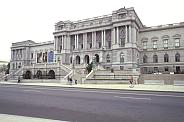
|
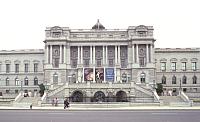
|
| |
|
| In the round upper windows are busts of nine great men, with Benjamin Franklin at the center flanked by the German poet Goethe and the British historian Thomas Macaulay. Other notables include Nathaniel Hawthorne, Washington Irving, Emerson, and Sir Walter Scott with Dante and Demosthenes on the south and north sides respectively. The nine great writers are by sculptors Herbert Adams, Frederick W. Ruckstull, and Jonathan Scott Hartley. Granite spandrel figures over the triple doors were sculpted by Bela Lyon Pratt. The pairs represent (from left to right) Literature, Science, and the Arts. Above the central portal, one allegorical figure holds the torch of knowledge while the figure on the right holds a celestial globe. (See below, right.) |
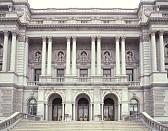
|

|

|
| |
|
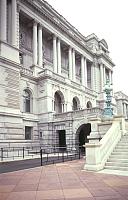
|

|
Left: View of the double staircase and basement carriage entrance from the north ; center: the entrance pavilion from the south with the bust portrait of Dante in the bull's eye window of the third register and partial view of corner pavilion |
| |
|
Views of the side with corner pavilions; distant view of the dome--over the central Reading Room |

|

|
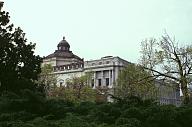
|













 Click here to return to index of art historical sites.
Click here to return to index of art historical sites.
 Click here to return to index of artists and architects.
Click here to return to index of artists and architects.
 Click here to return to chronological index.
Click here to return to chronological index.
 Click here to see the home page of Bluffton College.
Click here to see the home page of Bluffton College.
